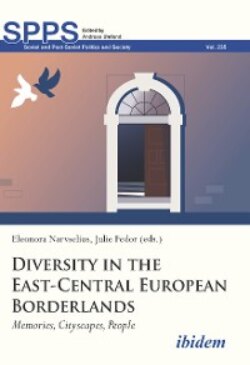Читать книгу Diversity in the East-Central European Borderlands - Группа авторов - Страница 15
На сайте Литреса книга снята с продажи.
Chişinău–Kišinev (Kishinev) Interwar Chişinău in Historical Context
ОглавлениеInterwar Chişinău mainly consisted of two parts, the old, village-like Moldovan town, and the regular grid town, developed under Russian rule (1812–1918). The old, poorer Moldovan town had small churches and traditional buildings, sometimes with porches or columns. Near its center, Piaţa Veche (the “Old Market”), were the Michael and Gabriel Cathedral (1742), the Armenian church (1803–04) and several synagogues. Jews, who made up 46% of the population in 1897, lived in both parts of the city. The Roman Catholic (1940) and Lutheran (1838) churches represented first and foremost the Poles and Germans respectively.3
Figure 2.1. Chişinău. Background map from 1941, showing streets where inhabitants and property owners were registered in 1930 or 1940, according to archival material. Map by the author, based on material from http://oldchisinau.com/starye-karty-i-ulicy/starye-karty-kishinyova/plan-kishinyova-1941-goda-2/.
After Bessarabia and Bukovina were formally incorporated into Romania on 27 November 1918, Romanian became the official language.4 The Latin alphabet was introduced, and the streets renamed.5 The main boulevard, Strada Alexandru cel Bun, was the location of the most important shops, cafés, restaurants, and hotels. By 1930, 48% of the inhabitants were Romanians, 36% Jews, and 17% Russians. Cultural life was intense.6
Figure 2.2. Chişinău. Property owners around Piaţa Veche (the Old Market) in 1930. Map by the author, based on material from Archivă Naţională in Chişinău, including hand-written lists from 1930, in the form Tablou pentru revizuirea numerotării clădirilor in oraşe (heads of households and number of persons in each household), and Luftwaffe aerial photos from May 1944. None of these buildings has survived. Buildings confirmed by old maps are marked dark grey. Buildings not definitively confirmed by old maps are shown in light gray. Their size and location are estimated. This district was within the ghetto area in 1941.
Figure 2.3. Chişinău. Buildings and property owners (1940) along the central part of Strada Mihai Viteazu (present-day Strada Mihai Eminescu). Map by the author, based on material from Archivă Naţională in Chişinău. From 1930 are hand-written lists, in the form Tablou pentru revizuirea numerotării clădirilor in oraşe (heads of households and number of persons in each household), and Luftwaffe aerial photo from May 1944. Dark gray: Preserved buildings. Buildings that have not been preserved are light gray in the printed version.
The large industrial exhibition in 1925, erected on the slopes down to present-day Lacul Morilor, expressed the new national ambitions. The buildings were characterized by the national Romanian neo-Romanesc or Brâncoveanu style (Nesterov 2011a: 96),7 Secession, and Art déco. From the 1930s, modernist architecture was used in parallel with Brâncoveanu style and neo-classicism. A guide book from 1932 (Rumänien 1932: 308 ff.) illustrates interwar urban life, mentioning the hotels Londra, Paris, Suisse, and Naţional as well as the cafés and restaurants Susana, Varşovia, Bernstein, and Manicov, and the travel agencies Wagon-Lits-Cook and Europa.8 A postcard shows the Hermes fashion store opposite the City Bank.9
The grid town was largely inhabited by representatives of the more affluent classes, but also poorer tenants in backyard buildings. The names that appear in the historical address books hint that most inhabitants were Jewish or Russian.10 The old pre-1812 town had poorer inhabitants; these were Jewish, especially around Piaţa Veche, and also Moldovan and Ukrainian. Around Strada Română were many synagogues. Important streets in the Old Town were Strada Petru Rareş, Strada Vineri,11 Strada Cahul, and Strada Alexandru Vlăhuţa. Strada Haralambie,12 with a pronounced Jewish character, featuring synagogues and prayer houses, formed the boundary between the Old Town and the grid town. There were also residents with Russian, Ukrainian, and Romanian names, for example on Strada Ecaterina Teodoriu and Strada Nicolae Bălcescu.
In the grid city, Strada Mihai Viteazu, Strada Ion G. Brătianu,13 and Strada Ştefan cel Mare14 had a mixed population. The listings for Strada General Brosteanu15 and Strada Regele Ferdinand16 include somewhat fewer Romanian names. At Strada Mareşal P. Badaglio17 the Jews were the largest ethnic group, especially in the lower parts of the street.18
In spite of rising anti-Semitism in the 1930s, the Jewish share of the total Chişinău population of 128,000 rose to 50% prior to World War II. In 1939 there were 65 synagogues and prayer houses in Chişinău in total (Bric 2017: 156–58).19 A central figure was Yehuda Leib Țirilson (Zirelson),20 in 1918 appointed Chief Rabbi of Bessarabia and from 1920 representative of the Bessarabian Jews in the Romanian parliament.
